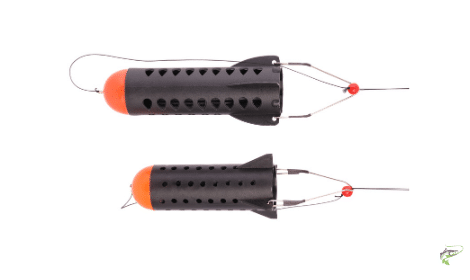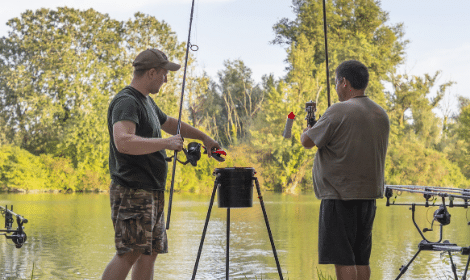
A question I hear far too often on the banks or fishing forums is “What is a spod?”. The benefits of using a spod in your carp fishing sessions can be huge, and everyone should at least know what they are. Using a spod is a simple technique to maximise your catching; that’s what we all want right?
What is a Spod?
Spods are a method to cast large quantities of bait to your swim to attract the hungry carp to your swim and keep them there. The more carp you have in your chosen swim, the bigger chance you have to catch them.
A spod is a rocket-shaped accessory you attach to the end of your line that can be filled with all sorts of baits.
Spods come in varying sizes and weights that can be used in different circumstances. Heavier spods come into play when you are looking to cast far distances (make sure your tackle is up to the test, but that will come further through this post).
Smaller spod will result in less splash when they hit the water which will minimize the chance of spooking the carp.
Bigger spods will have the potential to cast more bait but make sure not to go over the top with your baiting up until you determine how the carp are feeding.
Too much bait when the carp are less active can lower your chances of the carp finding your hook bait.
All spods will have a buoyant nose cone. When the spod hits the water, the nose cone will float to the top tipping your bait out of the end and into the water.
Some spods are sold with holes in the sides, and others have none. Spods with holes in the side allow the water to flow easily and empty your bait quickly.
Try to avoid using a spod with holes in the side when you are planning to bait with small baits such as hemp, micro pellets or even maggots as some of your bait will fly out as the spod travels through the air.
Spods are mainly used when you are baiting up an area out with a catapult or throwing range.
Catapulting or throwing baits can cause your bait to spread in the air whereas spodding will ensure all your bait is kept in a precise area.
Spods with more holes like the ones shown in the picture to the right will make retrieving the spod after the cast easier as less drag is created as water flows through the holes.
Spods are the best option when you are aiming to create large clouds in the water to attract hungry fish.
Have a read at my full guide on how to use a spod if you’re looking for some extra info!
Tackle for using a spod

When spods are filled with bait, they can become pretty heavy so you’ll need tackle to handle the added casting weight.
If you plan on using small and light spods, a heavy carp rod should be up to the test but for heavier spods make sure and bag yourself a specially designed spod rod and a heavy reel to go with it.
Specially designed spod rods are most commonly 12ft in length which helps to launch your spod far distances.
When casting heavy spods you will be looking to use a rod with a test curve around the 4lb mark or greater.
This will guarantee you can effectively and accurately every time as the rod won’t flex uncontrollable through the cast.
If you are looking for more information on what makes a suitable spod rod have a read at my spod rod post.
When choosing a reel for spodding you should look for a big pit reel loaded with braided line rated over 12lb and a shock leader to help take the brunt of the cast and reduce the change of you snapping and loosing a valuable spod and all the bait inside.
Braided lines allow you to cast further and more accurately as there is no stretch in the line so your spod should land bang on every time which is the key to spodding.
Bait Tips
Near enough any common baits can be used to fill your spod. These include groundbait, boilies, micro pellets, maggots, hemp and even the more unconventional baits like peperami, prawns and mussels.
Soaking your spod mix overnight in carp flavouring liquid can be an extremely effective method to add that extra attraction that you need.
When using the smaller baits make sure and use a spod with few or no holes at all to stop your bait from falling through the holes during the cast.
Make sure your mix isn’t too wet as this can mean your bait will not fall easily out of your spod even with a good few twitches of the rod. Adding some dry pellets ensures this doesn’t happen and your spod is emptied every time.
On the other hand, if you are spodding with a mainly dry mix it is good practice to top the end of your spod with a lightly mixed layer of ground bait that should help to minimize spod spill on the cast.
If not you will most likely lose a third of your expensive bait and which will be extremely useless dropping only meters from your peg.
Spomb, what’s the difference?

A spomb is an accessory that provides the same benefits as spodding. Spombs are also used to bait up far swims but work in a slightly different way than spods.
A spomb literally looks like a rocket and once filled your bait will be completely concealed. It’s as easy as opening the spomb by pushing the end and releasing the mechanism, filling it with bait and closing it back over.
Once your spomb is full make your cast and as your spomb hits the water, the mechanism will release dropping all of your bait.
Using a spomb has many benefits, one of them being that no bait will be lost on the cast, even dry mixes of small pellets.
Spombs are extremely aerodynamic which will help on the long distance casts and can make help make casting heavy spombs effortless.
Retrieving a spomb is also fairly easy as it will skip across the surface once opened.
Personally, I will opt for a spomb over a spod but whichever you choose is completely down to personal preference.
Give it a go!
Now that you know what a spod is there really is no reason not to give it a go. Using a spod or spomb for baiting up can turn any slow season into one full of excitement and plenty of fish. The concept is simple;
- Choose a swim
- Tie on your spod (or spomb)
- Cast to this swim and use your line clip to hit the same spot accurately
- Fill your spod
- Cast away
If you are new to carp fishing make sure and have a read at my “How to carp fish post” for plenty of tips and what you will need to get started. Once again if you have any question or anything to add please feel free to leave a comment below.

